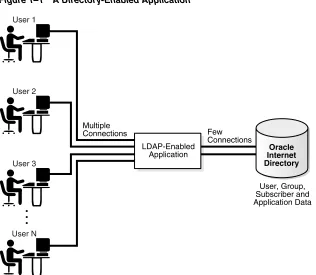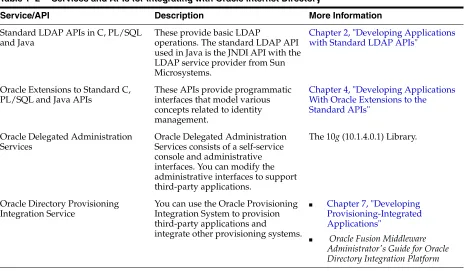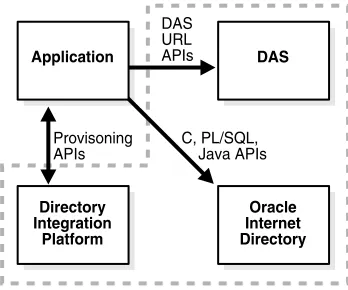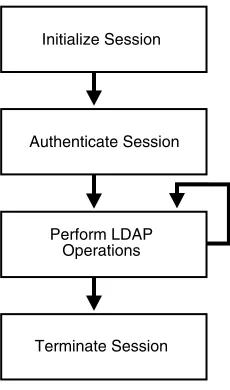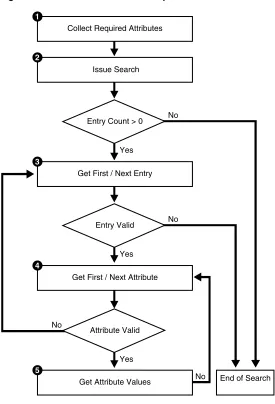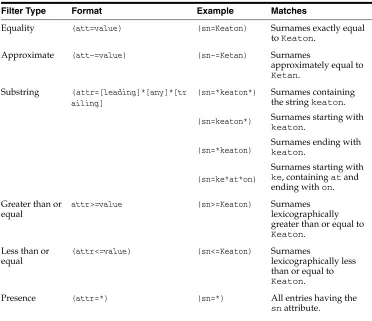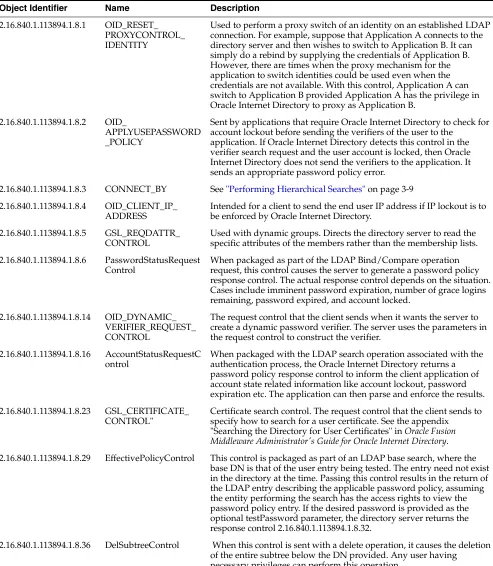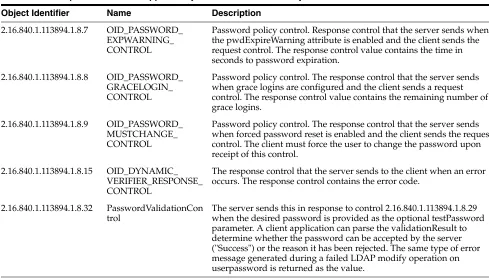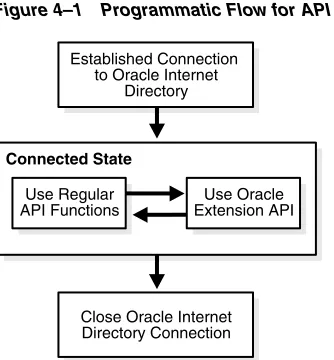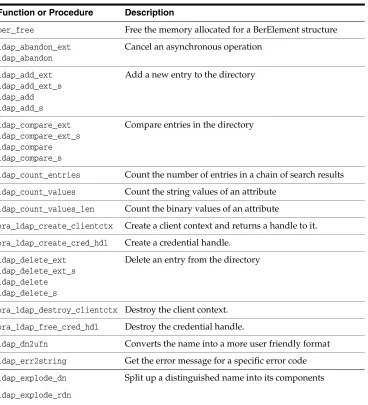Oracle® Fusion Middleware
Application Developer's Guide for Oracle Identity Management
11
g
Release 1 (11.1.1)
E10186-02
E10186-02
Copyright © 1999, 2011, Oracle and/or its affiliates. All rights reserved.
Primary Author: Ellen Desmond
Contributors: Vasuki Ashok , Ajay Keni, Ashish Kolli, Stephen Lee, Venkat Medam, Samit Roy, David Lin, Arun Theebaprakasam
This software and related documentation are provided under a license agreement containing restrictions on use and disclosure and are protected by intellectual property laws. Except as expressly permitted in your license agreement or allowed by law, you may not use, copy, reproduce, translate, broadcast, modify, license, transmit, distribute, exhibit, perform, publish, or display any part, in any form, or by any means. Reverse engineering, disassembly, or decompilation of this software, unless required by law for interoperability, is prohibited.
The information contained herein is subject to change without notice and is not warranted to be error-free. If you find any errors, please report them to us in writing.
If this software or related documentation is delivered to the U.S. Government or anyone licensing it on behalf of the U.S. Government, the following notice is applicable:
U.S. GOVERNMENT RIGHTS Programs, software, databases, and related documentation and technical data delivered to U.S. Government customers are "commercial computer software" or "commercial technical data" pursuant to the applicable Federal Acquisition Regulation and agency-specific supplemental regulations. As such, the use, duplication, disclosure, modification, and adaptation shall be subject to the restrictions and license terms set forth in the applicable Government contract, and, to the extent applicable by the terms of the Government contract, the additional rights set forth in FAR 52.227-19, Commercial Computer Software License (December 2007). Oracle USA, Inc., 500 Oracle Parkway, Redwood City, CA 94065.
This software is developed for general use in a variety of information management applications. It is not developed or intended for use in any inherently dangerous applications, including applications which may create a risk of personal injury. If you use this software in dangerous applications, then you shall be responsible to take all appropriate fail-safe, backup, redundancy, and other measures to ensure the safe use of this software. Oracle Corporation and its affiliates disclaim any liability for any damages caused by use of this software in dangerous applications.
Oracle is a registered trademark of Oracle Corporation and/or its affiliates. Other names may be trademarks of their respective owners.
This software and documentation may provide access to or information on content, products, and services from third parties. Oracle Corporation and its affiliates are not responsible for and expressly disclaim all warranties of any kind with respect to third-party content, products, and services. Oracle Corporation and its affiliates will not be responsible for any loss, costs, or damages incurred due to your access to or use of third-party content, products, or services.
Portions of this document are from "The C LDAP Application Program Interface," an Internet Draft of the Internet Engineering Task Force (Copyright (C) The Internet Society (1997-1999). All Rights Reserved), which expires on 8 April 2000. These portions are used in accordance with the following IETF directives: "This document and translations of it may be copied and furnished to others, and derivative works that comment on or otherwise explain it or assist in its implementation may be prepared, copied, published and distributed, in whole or in part, without restriction of any kind, provided that the above copyright notice and this paragraph are included on all such copies and derivative works. However, this document itself may not be modified in any way, such as by removing the copyright notice or references to the Internet Society or other Internet organizations, except as needed for the purpose of developing Internet standards in which case the procedures for copyrights defined in the Internet Standards process must be followed, or as required to translate it into languages other than English."
RSA and RC4 are trademarks of RSA Data Security. Portions of Oracle Internet Directory have been licensed by Oracle Corporation from RSA Data Security.
This product contains SSLPlus Integration SuiteTM version 1.2, from Consensus Development Corporation.
iii
Contents
Preface
... xviiAudience... xvii
Documentation Accessibility ... xvii
Related Documents ... xviii
Conventions ... xix
What's New in the SDK?
... xxiNew Features in the 11g Release 1 (11.1.1) SDK ... xxi
New Features in the 10g (10.1.4.0.1) SDK ... xxi
New Features in the Release 10.1.2 SDK... xxii
New Features in the Release 9.0.4 SDK... xxii
Part I
Programming for Oracle Identity Management
1
Developing Applications for Oracle Identity Management
Oracle Identity Management Services Available for Application Integration... 1-1
Integrating Existing Applications with Oracle Identity Management... 1-2
Oracle Identity Management Programming: An Overview... 1-2 Programming Languages Supported by the Oracle Internet Directory SDK ... 1-3 Oracle Identity Management SDK Components ... 1-3 Application Development in the Oracle Identity Management Environment ... 1-3 Architecture of an Oracle Identity Management Application... 1-3 Oracle Identity Management Interactions During the Application Life Cycle ... 1-4 Services and APIs for Integrating Applications with Oracle Identity Management ... 1-5 Integrating Existing Applications with Oracle Identity Management... 1-6
2
Developing Applications with Standard LDAP APIs
Sample Code... 2-1
History of LDAP... 2-1
Data Integrity... 2-6 Data Privacy... 2-6 Password Policies... 2-6
About the Standard LDAP APIs... 2-7 API Usage Model ... 2-7 Getting Started with the C API ... 2-7 Getting Started with the DBMS_LDAP Package ... 2-8 Getting Started with the Java API... 2-8
Initializing an LDAP Session... 2-8 Initializing the Session by Using the C API ... 2-8 Initializing the Session by Using DBMS_LDAP ... 2-9 Initializing the Session by Using JNDI... 2-9
Authenticating an LDAP Session... 2-10 Authenticating an LDAP Session by Using the C API ... 2-10 Authenticating an LDAP Session by Using DBMS_LDAP ... 2-11
Searching the Directory... 2-11 Program Flow for Search Operations... 2-12 Search Scope... 2-13 Filters... 2-14 Searching the Directory by Using the C API... 2-15 Searching the Directory by Using DBMS_LDAP ... 2-16
Terminating the Session... 2-17 Terminating the Session by Using the C API... 2-17 Terminating the Session by Using DBMS_LDAP... 2-18
3
Extensions to the LDAP Protocol
SASL Authentication... 3-1 SASL Authentication by Using DIGEST-MD5 ... 3-1 Steps Involved in SASL Authentication by Using DIGEST-MD5... 3-2 SASL Authentication by Using External Mechanism ... 3-3
Using Controls ... 3-3
Proxying on Behalf of End Users... 3-5
Creating Dynamic Password Verifiers... 3-6 Request Control for Dynamic Password Verifiers ... 3-7 Syntax for DynamicVerifierRequestControl ... 3-7 Parameters Required by the Hashing Algorithms ... 3-8 Configuring the Authentication APIs ... 3-8 Parameters Passed If ldap_search Is Used ... 3-8 Parameters Passed If ldap_compare Is Used ... 3-8 Response Control for Dynamic Password Verifiers ... 3-9 Obtaining Privileges for the Dynamic Verifier Framework ... 3-9
v
Paged LDAP Search Results... 3-11
Password Policies... 3-11 User Provisioning... 3-11 User Authentication... 3-12 LDAP Bind/Compare Operation-Based Authentication... 3-12 LDAP Search Operation-Based Authentication ... 3-13 User Account Maintenance... 3-14
4
Developing Applications With Oracle Extensions to the Standard APIs
Sample Code... 4-1
Using Oracle Extensions to the Standard APIs... 4-1
Creating an Application Identity in the Directory... 4-2 Creating an Application Identity ... 4-2 Assigning Privileges to an Application Identity ... 4-2
Managing Users... 4-3
Managing Groups... 4-3
Managing Realms... 4-3
Discovering a Directory Server... 4-4 Benefits of Oracle Internet Directory Discovery Interfaces... 4-4 Usage Model for Discovery Interfaces ... 4-5 Determining Server Name and Port Number From DNS... 4-5 Mapping the DN of the Naming Context... 4-6 Search by Domain Component of Local Machine... 4-6 Search by Default SRV Record in DNS... 4-6 Environment Variables for DNS Server Discovery... 4-7 Programming Interfaces for DNS Server Discovery... 4-7
5
Using the Java API Extensions to JNDI
Sample Code... 5-1
Installing the Java Extensions... 5-1
Using the oracle.ldap.util Package to Model LDAP Objects... 5-2
The Classes PropertySetCollection, PropertySet, and Property... 5-2
Managing Users... 5-3
Authenticating Users... 5-3
Creating Users... 5-4
Retrieving User Objects... 5-4
Retrieving Objects from Realms... 5-5
Example: Search for Oracle Single Sign-On Login Name... 5-5
Discovering a Directory Server... 5-6
Example: Discovering a Directory Server... 5-7
Using DIGEST-MD5 to Perform SASL Authentication... 5-8
Example: Using SASL Digest-MD5 auth-int and auth-conf Modes... 5-8
6
Using the API Extensions in PL/SQL
Sample Code... 6-1
Authenticating Users... 6-2
Dependencies and Limitations of the PL/SQL LDAP API... 6-2
7
Developing Provisioning-Integrated Applications
Part II
Oracle Internet Directory Programming Reference
8
C API Reference
About the Oracle Internet Directory C API... 8-1 Oracle Internet Directory SDK C API SSL Extensions... 8-1 SSL Interface Calls ... 8-2 Wallet Support... 8-2
Functions in the C API... 8-2 The Functions at a Glance ... 8-3 Initializing an LDAP Session... 8-5 ldap_init and ldap_open... 8-5 LDAP Session Handle Options ... 8-6 ldap_get_option and ldap_set_option ... 8-6 Getting Bind Credentials for Chasing Referrals ... 8-10 ldap_set_rebind_proc ... 8-10 Authenticating to the Directory ... 8-11 ldap_sasl_bind, ldap_sasl_bind_s, ldap_simple_bind, and ldap_simple_bind_s... 8-11 SASL Authentication Using Oracle Extensions ... 8-13 ora_ldap_init_SASL ... 8-14 ora_ldap_create_cred_hdl, ora_ldap_set_cred_props, ora_ldap_get_cred_props,
vii and ldap_err2string ... 8-33 Stepping Through a List of Results ... 8-36 ldap_first_message and ldap_next_message ... 8-36 Parsing Search Results... 8-36
ldap_first_entry, ldap_next_entry, ldap_first_reference, ldap_next_reference,
ldap_count_entries, and ldap_count_references... 8-37 ldap_first_attribute and ldap_next_attribute... 8-37 ldap_get_values, ldap_get_values_len, ldap_count_values,
ldap_count_values_len, ldap_value_free, and ldap_value_free_len ... 8-39 ldap_get_dn, ldap_explode_dn, ldap_explode_rdn, and ldap_dn2ufn ... 8-40 ldap_get_entry_controls ... 8-40 ldap_parse_reference... 8-41
Sample C API Usage... 8-42 C API Usage with SSL ... 8-42 C API Usage Without SSL... 8-43 C API Usage for SASL-Based DIGEST-MD5 Authentication ... 8-43 Setting and Using a Callback Function to Get Credentials When Chasing Referrals... 8-46
Required Header Files and Libraries for the C API... 8-48
Dependencies and Limitations of the C API... 8-48
9
DBMS_LDAP PL/SQL Reference
Summary of Subprograms... 9-1
Exception Summary... 9-3
Data Type Summary... 9-5
FUNCTION value_free_blob... 9-29 FUNCTION modify_s ... 9-29 FUNCTION add_s ... 9-30 PROCEDURE free_mod_array... 9-31 FUNCTION count_values ... 9-32 FUNCTION count_values_len ... 9-32 FUNCTION rename_s ... 9-33 FUNCTION explode_dn ... 9-34 FUNCTION open_ssl... 9-35 FUNCTION msgfree... 9-36 FUNCTION ber_free ... 9-37 FUNCTION nls_convert_to_utf8... 9-38 FUNCTION nls_convert_to_utf8... 9-38 FUNCTION nls_convert_from_utf8... 9-39 FUNCTION nls_convert_from_utf8... 9-40 FUNCTION nls_get_dbcharset_name ... 9-41
10
Java API Reference
11
DBMS_LDAP_UTL PL/SQL Reference
Summary of Subprograms... 11-1
ix Function normalize_dn_with_case... 11-24 Function get_property_names ... 11-24 Function get_property_values ... 11-25 Function get_property_values_len ... 11-26 Procedure free_propertyset_collection ... 11-27 Function create_mod_propertyset... 11-28 Function populate_mod_propertyset ... 11-29 Procedure free_mod_propertyset... 11-29 Procedure free_handle ... 11-30 Function check_interface_version ... 11-30 Function get_property_values_blob ... 11-31 Procedure property_value_free_blob ... 11-32
Function Return Code Summary... 11-32
Data Type Summary... 11-34
12
Oracle Directory Integration and Provisioning Java API Reference
Application Configuration... 12-1 Application Registration and Provisioning Configuration... 12-2 Application Registration ... 12-2 Provisioning Configuration... 12-4 Application Configuration Classes... 12-13
User Management... 12-14 Creating a User ... 12-14 Modifying a User... 12-15 Deleting a User ... 12-15 Looking Up a User ... 12-15
Debugging... 12-15
Sample Code... 12-16
13
Oracle Directory Integration Platform PL/SQL API Reference
Versioning of Provisioning Files and Interfaces... 13-1
Extensible Event Definition Configuration... 13-1
Inbound and Outbound Events... 13-3
PL/SQL Bidirectional Interface (Version 3.0)... 13-4
PL/SQL Bidirectional Interface (Version 2.0)... 13-8
Provisioning Event Interface (Version 1.1)... 13-9 Predefined Event Types ... 13-11 Attribute Type ... 13-11 Attribute Modification Type... 13-11 Event Dispositions Constants... 13-11 Callbacks... 13-11 GetAppEvent() ... 13-12 PutAppEventStatus()... 13-12 PutOIDEvent()... 13-12
Provisioning Plug-in Types and Their Purpose ... A-1
Provisioning Plug-in Requirements... A-2
Data Entry Provisioning Plug-in... A-2 Pre–Data-Entry Provisioning Plug-in ... A-4 Post–Data-Entry Provisioning Plug-in... A-5
Data Access Provisioning Plug-in ... A-6
Event Delivery Provisioning Plug-in... A-7
Provisioning Plug-in Return Status... A-10
Configuration Template for Provisioning Plug-ins... A-10
Sample Code for a Provisioning Plug-in... A-11
B
DSML Syntax
Capabilities of DSML... B-1
Benefits of DSML... B-1
DSML Syntax... B-2 Top-Level Structure ... B-2 Directory Entries ... B-2 Schema Entries... B-3
Tools Enabled for DSML... B-3
C
Migrating from Netscape LDAP SDK API to Oracle LDAP SDK API
Features... C-1
Functions... C-1
Macros... C-2
xi
List of Figures
1–1 Interactions During Application Lifecycle ... 1-4 1–2 Services and APIs for Integrating with Oracle Internet Directory ... 1-5 1–3 Services for Modifying Existing Applications ... 1-6 2–1 LDAP Functions ... 2-4 2–2 SSL Authentication Modes ... 2-5 2–3 Parameters for ldap_init()... 2-9 2–4 Arguments for ldap_simple_bind_s()... 2-11 2–5 Options for search_s() or search_st() Functions ... 2-13 2–6 Search Filters... 2-14 2–7 Boolean Operators ... 2-15 2–8 Arguments for ldap_search_s()... 2-16 2–9 Arguments for DBMS_LDAP.search_s() and DBMS_LDAP.search_st()... 2-17 3–1 Request Controls Supported by Oracle Internet Directory ... 3-3 3–2 Response Controls Supported by Oracle Internet Directory... 3-5 3–3 Parameters in DynamicVerifierRequestControl... 3-8 3–4 Parameters Required by the Hashing Algorithms... 3-8 4–1 Environment Variables for DNS Discovery ... 4-7 5–1 Methods for Directory Server Discovery... 5-6 8–1 Arguments for SSL Interface Calls ... 8-2 8–2 Functions and Procedures in the C API... 8-3 8–3 Parameters for Initializing an LDAP Session... 8-6 8–4 Parameters for LDAP Session Handle Options... 8-7 8–5 Constants... 8-8 8–6 Parameters for Callback Function and for Setting Callback Function ... 8-11 8–7 Parameters for Authenticating to the Directory... 8-12 8–8 Parameters passed to ora_ldap_init_sasl()... 8-14 8–9 Parameters for Managing SASL Credentials ... 8-16 8–10 Fields in ldapcontrol Structure ... 8-16 8–11 Parameters for Closing the Session ... 8-18 8–12 Parameters for Search Operations ... 8-20 8–13 Parameters for Compare Operations ... 8-22 8–14 Parameters for Modify Operations... 8-24 8–15 Fields in LDAPMod Structure... 8-24 8–16 Parameters for Rename Operations ... 8-26 8–17 Parameters for Add Operations... 8-28 8–18 Parameters for Delete Operations ... 8-29 8–19 Parameters for Extended Operations... 8-30 8–20 Parameters for Abandoning an Operation... 8-31 8–21 Parameters for Obtaining Results and Peeking Inside LDAP Messages... 8-32 8–22 Parameters for Handling Errors and Parsing Results ... 8-35 8–23 Parameters for Stepping Through a List of Results ... 8-36 8–24 Parameters for Retrieving Entries and Continuation References from a Search Result
Chain, and for Counting Entries Returned 8-37
8–25 Parameters for Stepping Through Attribute Types Returned with an Entry ... 8-38 8–26 Parameters for Retrieving and Counting Attribute Values ... 8-39 8–27 Parameters for Retrieving, Exploding, and Converting Entry Names ... 8-40 8–28 Parameters for Extracting LDAP Controls from an Entry ... 8-41 8–29 Parameters for Extracting Referrals and Controls from a SearchResultReference Message ..
8-41
xvii
Preface
Oracle Fusion Middleware Application Developer's Guide for Oracle Identity Management
explains how to modify applications to work with Oracle Identity Management, including Oracle Application Server Single Sign-On, Oracle Internet Directory, Oracle Delegated Administration Services, and the Directory Integration Platform.
This preface contains these topics:
■ Audience
■ Documentation Accessibility
■ Related Documents
■ Conventions
Audience
The following readers can benefit from this book:
■ Developers who want to integrate applications with Oracle Identity Management. This process involves storing and updating information in an Oracle Internet Directory server. It also involves modifying applications to work with mod_osso, an authentication module on the Oracle HTTP Server.
■ Anyone who wants to learn about the LDAP APIs and Oracle extensions to these APIs.
Documentation Accessibility
Our goal is to make Oracle products, services, and supporting documentation accessible to all users, including users that are disabled. To that end, our
documentation includes features that make information available to users of assistive technology. This documentation is available in HTML format, and contains markup to facilitate access by the disabled community. Accessibility standards will continue to evolve over time, and Oracle is actively engaged with other market-leading
technology vendors to address technical obstacles so that our documentation can be accessible to all of our customers. For more information, visit the Oracle Accessibility Program Web site at http://www.oracle.com/accessibility/.
Accessibility of Code Examples in Documentation
Screen readers may not always correctly read the code examples in this document. The conventions for writing code require that closing braces should appear on an
organizations that Oracle does not own or control. Oracle neither evaluates nor makes any representations regarding the accessibility of these Web sites.
Access to Oracle Support
Oracle customers have access to electronic support through My Oracle Support. For information, visit http://www.oracle.com/support/contact.html or visit
http://www.oracle.com/accessibility/support.html if you are hearing impaired.
Related Documents
For more information, see these Oracle resources:
■ Oracle Fusion Middleware Installation Guide for Oracle Identity Management
■ Oracle Internet Directory Administrator's Guide
■ Oracle Fusion Middleware Administrator's Guide for Oracle Directory Integration
Platform
■ PL/SQL User's Guide and Reference
■ Oracle Database Application Developer's Guide - Fundamentals
■ Oracle Fusion Middleware Reference for Oracle Security Developer Tools
If you are using Oracle Delegated Administration Services or Oracle Single Sign-On 10g (10.1.4.3.0) or later, please refer to the following documents in the Oracle
Application Server 10g (10.1.4.0.1) library:
■ Oracle Identity Management Guide to Delegated Administration
■ Oracle Application Server Single Sign-On Administrator's Guide For additional information, see:
■ Chadwick, David. Understanding X.500—The Directory. Thomson Computer Press, 1996.
■ Howes, Tim and Mark Smith. LDAP: Programming Directory-enabled Applications
with Lightweight Directory Access Protocol. Macmillan Technical Publishing, 1997.
■ Howes, Tim, Mark Smith and Gordon Good, Understanding and Deploying LDAP
Directory Services. Macmillan Technical Publishing, 1999.
■ Internet Assigned Numbers Authority home page, http://www.iana.org, for information about object identifiers
■ Internet Engineering Task Force (IETF) documentation available at:
http://www.ietf.org, especially:
■ The LDAPEXT charter and LDAP drafts
■ The LDUP charter and drafts
■ RFC 2251, "Lightweight Directory Access Protocol (v3)"
■ RFC 2254, "The String Representation of LDAP Search Filters"
xix
Conventions
The following text conventions are used in this document:
Convention Meaning
boldface Boldface type indicates graphical user interface elements associated with an action, or terms defined in text or the glossary.
italic Italic type indicates book titles, emphasis, or placeholder variables for which you supply particular values.
xxi
What's New in the SDK?
This document acquaints you with new features of the Software Developer's Kit (SDK) for Oracle Identity Management—both in the present release and in previous releases. Use the links provided to learn more about each feature.
As of Release 11g Release 1 (11.1.1), the recommended security API for Fusion Middleware application developers is Oracle Platform Security for Java, which is documented in the Oracle Fusion Middleware Application Security Guide. The Oracle Identity Management interfaces described in the current book are supported for developers who maintain and extend existing solutions already integrated with the SDK.
Oracle Fusion Middleware 11g Release 1 (11.1.1) does not include Oracle Single Sign-On or Oracle Delegated Administration Services. Oracle Internet Directory 11g
Release 1 (11.1.1), however, is compatible with Oracle Single Sign-On 10g (10.1.4.3.0) and Oracle Delegated Administration Services 10g (10.1.4.3.0).
New Features in the 11g Release 1 (11.1.1) SDK
The 11g Release 1 (11.1.1) SDK adds support for Internet Protocol version 6 (IPv6). The C and Java APIs now support both IPv6 and IPv4 addresses.
New Features in the 10g (10.1.4.0.1) SDK
The 10g (10.1.4.0.1) SDK adds:■ Java plug-in support.
Server plug-ins can now be written in Java and in PL/SQL. For more information, please see Oracle Fusion Middleware Administrator's Guide for Oracle Internet
Directory for more information.
■ Paging and sorting of LDAP search results.
You can now obtain paged and sorted results from LDAP searches. For more information, please see "Sorted LDAP Search Results" and "Paged LDAP Search Results" in Chapter 3, "Extensions to the LDAP Protocol".
■ Added functionality for hierarchical searches.
You can now traverse the hierarchy in either direction and specify the number of levels of the hierarchy to search. For more information, please see "Performing Hierarchical Searches"in Chapter 3, "Extensions to the LDAP Protocol".
more information, please see "SASL Authentication" in Chapter 3, "Extensions to the LDAP Protocol" and "Example: Using SASL Digest-MD5 auth-int and auth-conf Modes" in Chapter 5, "Using the Java API Extensions to JNDI".
New Features in the Release 10.1.2 SDK
The release 10.1.2 SDK adds:■ Centralized user provisioning.
This feature enables you to provision application users into the Oracle Identity Management infrastructure. To learn more, see Chapter 12, "Oracle Directory Integration and Provisioning Java API Reference".
■ Dynamic password verifiers
This feature addresses the needs of applications that provide parameters for password verifiers only at runtime. To learn more, see "Creating Dynamic Password Verifiers" in Chapter 3.
■ Binary support for ldapmodify, ldapadd, and ldapcompare plug-ins
Directory plug-ins can now access binary attributes in the directory database. To learn more, see "Binary Support in the PL/SQLPlug-in Framework" in Oracle Fusion Middleware Administrator's Guide for Oracle Internet Directory.
■ Plug-in support for the Oracle Directory Integration and Provisioning Server
These Java hooks enable an enterprise to incorporate its own business rules and to tailor footprint creation to its needs. To learn more, see Appendix A.
New Features in the Release 9.0.4 SDK
The following features made their debut in the release 9.0.4 SDK:
■ URL API for Oracle Delegated Administration Services
This API enables you to build administrative and self-service consoles that delegated administrators can use to perform directory operations.
■ PL/SQL API Enhancements:
■ New functions in the LDAP v3 standard. Previously available only in the C API, these functions are now available in PL/SQL.
■ Functions that enable proxied access to middle-tier applications.
■ Functions that create and manage provisioning profiles in the Oracle Directory Integration and Provisioning.
To learn more, see Chapter 7.
■ Plug-in support for external authentication
This feature enables administrators to use Microsoft Active Directory to store and manage security credentials for Oracle components. Chapter 12
xxiii ■ XML support for the directory SDK and directory tools
This feature enables LDAP tools to process XML and LDIF notation. Directory APIs can manipulate data in a DSML 1.0 format.
■ Caching for client-side referrals
Part I
Part I
Programming for Oracle Identity
Management
Part I shows you how to modify your applications to work with the different
components of Oracle Identity Management. This section begins with an introduction to the Oracle Internet Directory SDK and to LDAP programming concepts. You then learn how to use the three LDAP APIs and their extensions to enable applications for Oracle Internet Directory.
Part I contains these chapters:
■ Chapter 1, "Developing Applications for Oracle Identity Management"
■ Chapter 2, "Developing Applications with Standard LDAP APIs"
■ Chapter 3, "Extensions to the LDAP Protocol"
■ Chapter 4, "Developing Applications With Oracle Extensions to the Standard APIs"
■ Chapter 5, "Using the Java API Extensions to JNDI"
■ Chapter 6, "Using the API Extensions in PL/SQL"
1
Developing Applications for Oracle Identity Management 1-1
1
Developing Applications for Oracle Identity
Management
As of Release 11g Release 1 (11.1.1), the recommended security API for Fusion Middleware application developers is Oracle Platform Security for Java, which is documented in the Fusion Middleware Security Guide. The Oracle Identity Management interfaces described in the current book are not part of Oracle Platform Security for Java.
Oracle Identity Management provides a shared infrastructure for all Oracle applications. It also provides services and interfaces that facilitate third-party enterprise application development. These interfaces are useful for application developers who need to incorporate identity management into their applications.
This chapter discusses these interfaces and recommends application development best practices in the Oracle Identity Management environment.
This chapter contains the following topics:
■ Oracle Identity Management Services Available for Application Integration
■ Integrating Existing Applications with Oracle Identity Management
■ Oracle Identity Management Programming: An Overview
Oracle Identity Management Services Available for Application Integration
Custom applications can use Oracle Identity Management through a set ofdocumented and supported services and APIs. For example:
■ Oracle Internet Directory provides LDAP APIs for C, Java, and PL/SQL, and is compatible with other LDAP SDKs.
■ Oracle Delegated Administration Services provides a core self-service console that can be customized to support third-party applications. In addition, they provide several services for building customized administration interfaces that manipulate directory data.
■ Oracle Directory Integration Services facilitate the development and deployment of custom solutions for synchronizing Oracle Internet Directory with third-party directories and other user repositories.
■ Oracle Single Sign-On provides APIs for developing and deploying partner applications that share a single sign-on session with other Oracle Web applications.
■ JAZN is the Oracle implementation of the Java Authentication and Authorization Service (JAAS) Support standard. JAZN allows applications developed for the Web using the Oracle J2EE environment to use the identity management infrastructure for authentication and authorization.
Integrating Existing Applications with Oracle Identity Management
For new applications, use Oracle Platform Security for Java, which is documented in the Fusion Middleware Security Guide.
An enterprise may have already deployed certain applications to perform critical business functions. Oracle Identity Management provides the following services that can be leveraged by the deployment to modify existing applications:
■ Automated User Provisioning: The deployment can develop a custom provisioning agent that automates the provisioning of users in the existing application in response to provisioning events in the Oracle Identity Management infrastructure. This agent must be developed using the interfaces of Oracle Provisioning Integration Service.
■ User Authentication Services: If the user interface of the existing application is based on HTTP, integrating it with Oracle HTTP Server and protecting its URL using mod_osso authenticates all incoming user requests using the Oracle Single Sign-On service.
■ Centralized User Profile Management: If the user interface of the existing application is based on HTTP, and it is integrated with Oracle Single Sign-On for authentication, the application can use the self-service console of Oracle Delegated Administration Services to enable centralized user profile management. The self-service console can be customized by the deployment to address the specific needs of the application.
Oracle Identity Management Programming: An Overview
This section introduces you to the Oracle Identity Management Software Developer's Kit. It provides an overview of how an application can use the kit to integrate with the directory. You are also acquainted with the rest of the directory product suite.
The section contains these topics:
Note: Oracle Fusion Middleware 11g Release 1 (11.1.1) does not include Oracle Single Sign-On or Oracle Delegated Administration Services. Oracle Internet Directory 11g Release 1 (11.1.1), however, is compatible with Oracle Single Sign-On and Oracle Delegated Administration Services 10g (10.1.4.3.0) or later.
See Also: Oracle Fusion Middleware Administrator's Guide for Oracle Internet Directory for more information about developing
Oracle Identity Management Programming: An Overview
Developing Applications for Oracle Identity Management 1-3 ■ Application Development in the Oracle Identity Management Environment
Programming Languages Supported by the Oracle Internet Directory SDK
The SDK is for application developers who use C, C++, and PL/SQL. Java developers must use the JNDI provider from Sun Microsystems to integrate with the directory.
Oracle Identity Management SDK Components
The Oracle Identity Management Software Developer's Kit 11g Release 1 (11.1.1) consists of the following:
■ A C API compliant with LDAP Version 3
■ A PL/SQL API contained in a PL/SQL package called DBMS_LDAP
■ Oracle Identity Management Application Developer's Guide (this document)
■ Command-line tools
Application Development in the Oracle Identity Management Environment
This section contains these topics:
■ Architecture of an Oracle Identity Management Application
■ Oracle Identity Management Interactions During the Application Life Cycle
■ Services and APIs for Integrating Applications with Oracle Identity Management
■ Integrating Existing Applications with Oracle Identity Management
Architecture of an Oracle Identity Management Application
Most Oracle Identity Management applications are back-end programs that
Figure 1–1 A Directory-Enabled Application
As Figure 1–1 shows, when a user request involves an LDAP-enabled operation, the application processes the request using a smaller set of pre-created directory
connections.
Oracle Identity Management Interactions During the Application Life Cycle
Table 1–1 on page 1-4 walks you through the directory operations that an application typically performs during its lifecycle.
Table 1–1 Interactions During Application Lifecycle
Point in Application Lifecycle Logic
Application Installation 1. Create an application identity in the directory. The application uses this identity to perform most of its LDAP operations.
2. Give the application identity LDAP
authorizations by making it part of the correct LDAP groups. These authorizations enable the application to accept user credentials and authenticate them against the directory. The directory can also use application authorizations to proxy for the user when LDAP operations must be performed on the user's behalf. Application Startup and Bootstrap The application must retrieve credentials that enable
it to authenticate itself to the directory.
If the application stores configuration metadata in Oracle Internet Directory, it can retrieve that metadata and initialize other parts of the application. The application can then establish a pool of
connections to serve user requests.
Oracle Internet Directory
User, Group, Subscriber and Application Data LDAP-Enabled
Application
User 2
User N User 1
User 3
Few Connections Multiple
Connections
Oracle Identity Management Programming: An Overview
Developing Applications for Oracle Identity Management 1-5
Services and APIs for Integrating Applications with Oracle Identity Management
Application developers can integrate with Oracle Identity Management by using the services and APIs listed and described in Table 1–2 on page 1-5.Figure 1–2 shows an application leveraging some of the services illustrated in Table 1–2 on page 1-5.
Application Runtime For every end-user request that needs an LDAP operation, the application can:
■ Pick a connection from the pool of LDAP
connections.
■ Switch the user to the end-user identity if the
LDAP operation must be performed with the effective rights of the end-user.
■ Perform the LDAP operation by using either the
regular API or the API enhancements described in this chapter.
■ Ensure that the effective user is now the
application identity when the LDAP operation is complete.
■ Return the LDAP connection back to the pool of
connections.
Application Shutdown Abandon any outstanding LDAP operations and close all LDAP connections.
Application Deinstallation Remove the application identity and the LDAP authorizations granted to it.
Table 1–2 Services and APIs for Integrating with Oracle Internet Directory
Service/API Description More Information
Standard LDAP APIs in C, PL/SQL and Java
These provide basic LDAP
operations. The standard LDAP API used in Java is the JNDI API with the LDAP service provider from Sun Microsystems.
Chapter 2, "Developing Applications with Standard LDAP APIs"
Oracle Extensions to Standard C, PL/SQL and Java APIs
These APIs provide programmatic interfaces that model various concepts related to identity management.
Chapter 4, "Developing Applications With Oracle Extensions to the Standard APIs"
Oracle Delegated Administration Services
Oracle Delegated Administration Services consists of a self-service console and administrative interfaces. You can modify the administrative interfaces to support third-party applications.
The 10g (10.1.4.0.1) Library.
Oracle Directory Provisioning Integration Service
You can use the Oracle Provisioning Integration System to provision third-party applications and integrate other provisioning systems.
■ Chapter 7, "Developing
Provisioning-Integrated Applications"
■ Oracle Fusion Middleware
Administrator's Guide for Oracle Directory Integration Platform
Table 1–1 (Cont.) Interactions During Application Lifecycle
Figure 1–2 An Application Leveraging APIs and Services
As Figure 1–2 shows, the application integrates with Oracle Internet Directory as follows:
■ Using PL/SQL, C, or Java APIs, it performs LDAP operations directly against the directory.
■ In some cases, it directs users to self-service features of Oracle Delegated Administration Services.
■ It is notified of changes to entries for users or groups in Oracle Internet Directory. The Oracle Directory Provisioning Integration Service provides this notification.
Integrating Existing Applications with Oracle Identity Management
Your enterprise may already have deployed applications that you may have wanted to integrate with the Oracle identity management infrastructure. You can integrate these applications using the services presented in Table 1–3.
Table 1–3 Services for Modifying Existing Applications
Service Description More Information
Automated User Provisioning You can develop an agent that automatically provisions users when provisioning events occur in the Oracle identity management infrastructure. You use interfaces of the Oracle Directory Provisioning Integration Service to develop this agent.
Chapter 7, "Developing Provisioning-Integrated Applications"
User Authentication Services If your user interface is based on HTTP, you can integrate it with the Oracle HTTP Server. This enables you to use mod_osso and OracleAS Single Sign-On to protect the application URL.
Oracle Application Server Single Sign-On Administrator's Guide
Centralized User Profile Management
If your user interface is based on HTTP and is integrated with OracleAS Single Sign-On, you can use the Oracle Internet Directory Self-Service Console to manage user profiles centrally. You can tailor the
■ The 10g (10.1.4.0.1) library. ■ The chapter about the delegated
2
Developing Applications with Standard LDAP APIs 2-1
2
Developing Applications with Standard
LDAP APIs
This chapter takes a high-level look at the operations that the standard LDAP API enables. It explains how to integrate your applications with the API. Before presenting these topics, the chapter revisits the Lightweight Directory Access Protocol (LDAP).
This chapter contains these topics:
■ Sample Code
■ History of LDAP
■ LDAP Models
■ About the Standard LDAP APIs
■ Initializing an LDAP Session
■ Authenticating an LDAP Session
■ Searching the Directory
■ Terminating the Session
Sample Code
Sample code is available at this URL:
http://www.oracle.com/technology/sample_code/
Look for the Oracle Identity Management link under Sample Applications—Fusion Middleware.
History of LDAP
LDAP began as a lightweight front end to the X.500 Directory Access Protocol. LDAP simplifies the X.500 Directory Access Protocol in the following ways:
■ It uses TCP/IP connections. These are lightweight compared to the OSI communication stack required by X.500 implementations
■ It eliminates little-used and redundant features of the X.500 Directory Access Protocol
■ It uses a simplified version of the X.500 encoding rules used to transport data over networks.
LDAP Models
LDAP uses four basic models to define its operations:
■ Naming Model
■ Information Model
■ Functional Model
■ Security Model
Naming Model
The LDAP naming model enables directory information to be referenced and organized. Each entry in a directory is uniquely identified by a distinguished name (DN). The DN tells you exactly where an entry resides in the directory hierarchy. A directory information tree (DIT) is used to represent this hierarchy.
Figure 2–1 illustrates the relationship between a distinguished name and a directory information tree.
Figure 2–1 A Directory Information Tree
The DIT in Figure 2–1 shows entries for two employees of Example Corporation who are both named Anne Smith. It is structured along geographical and organizational lines. The Anne Smith represented by the left branch works in the Sales division in the United States. Her counterpart works in the Server Development division in the United Kingdom.
The Anne Smith represented by the right branch has the common name (cn) Anne Smith. She works in an organizational unit (ou) named Server Development, in the country (c) of United Kingdom of Great Britain and Northern Ireland (uk), in the organization (o) Example. The DN for this Anne Smith entry looks like this:
cn=Anne Smith,ou=Server Development,c=uk,o=example
Note that the conventional format for a distinguished name places the lowest DIT component at the left. The next highest component follows, on up to the root.
Within a distinguished name, the lowest component is called the relative distinguished name (RDN). In the DN just presented, the RDN is cn=Anne Smith. The RDN for the
c=us
ou=Sales ou=Server Development
cn=Anne Smith cn=Anne Smith
c=uk root
LDAP Models
Developing Applications with Standard LDAP APIs 2-3 To locate a particular entry within the overall DIT, a client uniquely identifies that entry by using the full DN—not simply the RDN—of that entry. To avoid confusion between the two Anne Smiths in the global organization depicted in Figure 2–1, you use the full DN for each. If there are two employees with the same name in the same organizational unit, you can use other mechanisms. You may, for example, use a unique identification number to identify these employees.
Information Model
The LDAP information model determines the form and character of information in the directory. This model uses the concept of entries as its defining characteristic. In a directory, an entry is a collection of information about an object. A telephone directory, for example, contains entries for people. A library card catalog contains entries for books. An online directory may contain entries for employees, conference rooms, e-commerce partners, or shared network resources such as printers.
In a typical telephone directory, a person entry contains an address and a phone number. In an online directory, each of these pieces of information is called an
attribute. A typical employee entry contains attributes for a job title, an e-mail address, and a phone number.
In Figure 2–2, the entry for Anne Smith in Great Britain (uk) has several attributes. Each provides specific information about her. Those listed in the balloon to the right of the tree are emailaddrs, printername, jpegPhoto, and app preferences. Note that the rest of the bullets in Figure 2–2 are also entries with attributes, although these attributes are not shown.
Figure 2–2 Attributes of the Entry for Anne Smith
Each attribute consists of an attribute type and one or more attribute values. The attribute type is the kind of information that the attribute contains—jobTitle, for instance. The attribute value is the actual information. The value for the jobTitle attribute, for example, might be manager.
Functional Model
Security Model
The LDAP security model enables directory information to be secured. This model has several parts:
■ Authentication
Ensuring that the identities of users, hosts, and clients are correctly validated
■ Access Control and Authorization
Ensuring that a user reads or updates only the information for which that user has privileges
■ Data Integrity: Ensuring that data is not modified during transmission
■ Data Privacy
Ensuring that data is not disclosed during transmission
■ Password Policies
Setting rules that govern how passwords are used
Authentication
Authentication is the process by which the directory server establishes the identity of the user connecting to the directory. Directory authentication occurs when an LDAP bind operation establishes an LDAP session. Every session has an associated user identity, also referred to as an authorization ID.
Oracle Internet Directory provides three authentication options: anonymous, simple, Table 2–1 LDAP Functions
Function Description
Search and read The read operation retrieves the attributes of an entry whose name is known. The list operation enumerates the children of a given entry. The search operation selects entries from a defined area of the tree based on some selection criteria known as a search filter. For each matching entry, a requested set of attributes (with or without values) is returned. The searched entries can span a single entry, an entry's children, or an entire subtree. Alias entries can be followed automatically during a search, even if they cross server boundaries. An abandon operation is also defined, allowing an operation in progress to be canceled.
Modify This category defines four operations that modify the directory:
■ Modify—change existing entries. You can add and delete
values.
■ Add—insert entries into the directory ■ Delete—remove entries from the directory ■ Modify RDN—change the name of an entry
LDAP Models
Developing Applications with Standard LDAP APIs 2-5
Anonymous Authentication If your directory is available to everyone, users may log in anonymously. In anonymous authentication, users leave the user name and password fields blank when they log in. They then exercise whatever privileges are specified for anonymous users.
Simple Authentication In simple authentication, the client uses an unencrypted DN and password to identify itself to the server. The server verifies that the client's DN and password match the DN and password stored in the directory.
Authentication Using Secure Sockets Layer (SSL) Secure Sockets Layer (SSL) is an industry standard protocol for securing network connections. It uses a certificate exchange to authenticate users. These certificates are verified by trusted certificate authorities. A certificate ensures that an entity's identity information is correct. An entity can be an end user, a database, an administrator, a client, or a server. A Certificate Authority (CA) is an application that creates public key certificates that are given a high level of trust by all parties involved.
You can use SSL in one of the three authentication modes presented in Table 2–2.
In an Oracle Internet Directory environment, SSL authentication between a client and a directory server involves three basic steps:
1. The user initiates an LDAP connection to the directory server by using SSL on an SSL port. The default SSL port is 3131.
2. SSL performs the handshake between the client and the directory server.
3. If the handshake is successful, the directory server verifies that the user has the appropriate authorization to access the directory.
Access Control and Authorization
The authorization process ensures that a user reads or updates only the information for which he or she has privileges. The directory server ensures that the user— identified by the authorization ID associated with the session—has the requisite permissions to perform a given directory operation. Absent these permissions, the operation is disallowed.
The mechanism that the directory server uses to ensure that the proper authorizations are in place is called access control. And an access control item (ACI) is the directory metadata that captures the administrative policies relating to access control.
An ACI is stored in Oracle Internet Directory as user-modifiable operational attributes. Typically a whole list of these ACI attribute values is associated with a directory object. Table 2–2 SSL Authentication Modes
SSL Mode Description
No authentication Neither the client nor the server authenticates itself to the other. No certificates are sent or exchanged. In this case, only SSL encryption and decryption are used.
One-way authentication Only the directory server authenticates itself to the client. The directory server sends the client a certificate verifying that the server is authentic.
Two-way authentication Both client and server authenticate themselves to each other, exchanging certificates.
This list is called an access control list (ACL). The attribute values on that list govern the access policies for the directory object.
ACIs are stored as text strings in the directory. These strings must conform to a well-defined format. Each valid value of an ACI attribute represents a distinct access control policy. These individual policy components are referred to as ACI Directives or ACIs and their format is called the ACI Directive format.
Access control policies can be prescriptive: their security directives can be set to apply downward to all entries at lower positions in the directory information tree (DIT). The point from which an access control policy applies is called an access control policy point (ACP).
Data Integrity
Oracle Internet Directory uses SSL to ensure that data is not modified, deleted, or replayed during transmission. This feature uses cryptographic checksums to generate a secure message digest. The checksums are created using either the MD5 algorithm or the Secure Hash Algorithm (SHA). The message digest is included in each network packet.
Data Privacy
Oracle Internet Directory uses public key encryption over SSL to ensure that data is not disclosed during transmission. In public-key encryption, the sender of a message encrypts the message with the public key of the recipient. Upon delivery, the recipient decrypts the message using his or her private key. The directory supports two levels of encryption:
■ DES40
The DES40 algorithm, available internationally, is a DES variant in which the secret key is preprocessed to provide forty effective key bits. It is designed for use by customers outside the USA and Canada who want to use a DES-based
encryption algorithm.
■ RC4_40
Oracle is licensed to export the RC4 data encryption algorithm with a 40-bit key size to virtually all destinations where Oracle products are available. This makes it possible for international corporations to safeguard their entire operations with fast cryptography.
Password Policies
A password policy is a set of rules that govern how passwords are used. When a user attempts to bind to the directory, the directory server uses the password policy to ensure that the password provided meets the various requirements set in that policy.
When you establish a password policy, you set the following types of rules, to mention just a few:
■ The maximum length of time a given password is valid
■ The minimum number of characters a password must contain
About the Standard LDAP APIs
Developing Applications with Standard LDAP APIs 2-7
About the Standard LDAP APIs
The standard LDAP APIs enable you to perform the fundamental LDAP operations described in "LDAP Models". These APIs are available in C, PL/SQL, and Java. The first two are part of the directory SDK. The last is part of the JNDI package provided by Sun Microsystems. All three use TCP/IP connections. They are based on LDAP Version 3, and they support SSL connections to Oracle Internet Directory.
This section contains these topics:
■ API Usage Model
■ Getting Started with the C API
■ Getting Started with the Java API
■ Getting Started with the DBMS_LDAP Package
API Usage Model
Typically, an application uses the functions in the API in four steps:
1. Initialize the library and obtain an LDAP session handle.
2. Authenticate to the LDAP server if necessary.
3. Perform some LDAP operations and obtain results and errors, if any.
4. Close the session.
Figure 2–3 illustrates these steps.
Figure 2–3 Steps in Typical DBMS_LDAP Usage
Getting Started with the C API
When you build applications with the C API, you must include the header file ldap.h, located at $ORACLE_HOME/ldap/public. In addition, you must dynamically link to the library located at $ORACLE_
HOME/lib/libclntsh.so.10.1.
See Also: "Sample C API Usage" on page 8-42 to learn how to use the SSL and non-SSL modes.
Initialize Session
Authenticate Session
Perform LDAP Operations
Getting Started with the DBMS_LDAP Package
The DBMS_LDAP package enables PL/SQL applications to access data located in enterprise-wide LDAP servers. The names and syntax of the function calls are similar to those of the C API. These functions comply with current recommendations of the Internet Engineering Task Force (IETF) for the C API. Note though that the PL/SQL API contains only a subset of the functions available in the C API. Most notably, only synchronous calls to the LDAP server are available in the PL/SQL API.
To begin using the PL/SQL LDAP API, use this command sequence to load DBMS_ LDAP into the database:
1. Log in to the database, using SQL*Plus. Run the tool in the Oracle home in which your database is present. Connect as SYSDBA.
SQL> CONNECT / AS SYSDBA
2. Load the API into the database, using this command:
SQL> @?/rdbms/admin/catladap.sql
Getting Started with the Java API
Java developers can use the Java Naming and Directory Interface (JNDI) from Sun Microsystems to gain access to information in Oracle Internet Directory. The JNDI is found at this link:
http://java.sun.com/products/jndi
Although no Java APIs are provided in this chapter, the section immediately following, "Initializing the Session by Using JNDI", shows you how to use wrapper methods for the Sun JNDI to establish a basic connection.
Initializing an LDAP Session
All LDAP operations based on the C API require clients to establish an LDAP session with the LDAP server. For LDAP operations based on the PL/SQL API, a database session must first initialize and open an LDAP session. Most Java operations require a Java Naming and Directory Interface (JNDI) connection. The
oracle.ldap.util.jndi package, provided here, simplifies the work involved in achieving this connection.
The section contains the following topics:
■ Initializing the Session by Using the C API
■ Initializing the Session by Using DBMS_LDAP
■ Initializing the Session by Using JNDI
Initializing the Session by Using the C API
The C function ldap_init() initializes a session with an LDAP server. The server is not actually contacted until an operation is performed that requires it, allowing options to be set after initialization.
ldap_init has the following syntax:
Initializing an LDAP Session
Developing Applications with Standard LDAP APIs 2-9 );
Table 2–3 lists and defines the function parameters.
ldap_init() and ldap_open() both return a session handle, or pointer, to an opaque structure that must be passed to subsequent calls to the session. These routines return NULL if the session cannot be initialized. You can check the error reporting mechanism for your operating system to determine why the call failed.
Initializing the Session by Using DBMS_LDAP
In the PL/SQL API, the function DBMS_LDAP.init() initiates an LDAP session. This function has the following syntax:
FUNCTION init (hostname IN VARCHAR2, portnum IN PLS_INTEGER ) RETURN SESSION;
The function init requires a valid host name and port number to establish an LDAP session. It allocates a data structure for this purpose and returns a handle of the type DBMS_LDAP.SESSION to the caller. The handle returned from the call should be used in all subsequent LDAP operations defined by DBMS_LDAP for the session. The API uses these session handles to maintain state about open connections, outstanding requests, and other information.
A single database session can obtain as many LDAP sessions as required, although the number of simultaneous active connections is limited to 64. One database session typically has multiple LDAP sessions when data must be obtained from multiple servers simultaneously or when open sessions that use multiple LDAP identities are required.
Initializing the Session by Using JNDI
The oracle.ldap.util.jndi package supports basic connections by providing wrapper methods for the JNDI implementation from Sun Microsystems. If you want to use the JNDI to establish a connection, see the following link:
Table 2–3 Parameters for ldap_init()
Parameter Description
hostname Contains a space-separated list of directory host names or IP addresses represented by dotted strings. You can pair each host name with a port number if you use a colon to separate the two.
The hosts are tried in the order listed until a successful connection is made.
Note: A suitable representation for including a literal IPv6[10] address in the host name parameter is desired, but has not yet been determined or implemented in practice.
portno Contains the TCP port number of the directory you would like to connect to. The default LDAP port of 3060 can be obtained by supplying the constant LDAP_PORT. If a host includes a port number, this parameter is ignored.
http://java.sun.com/products/jndi
Here is an implementation of oracle.ldap.util.jndi that establishes a non-SSL connection:
import oracle.ldap.util.jndi import javax.naming.*;
public static void main(String args[]) {
try{
InitialDirContext ctx = ConnectionUtil.getDefaultDirCtx(args[0], // host args[1], // port args[2], // DN args[3]; // password) // Do work
}
catch(NamingException ne) {
// javax.naming.NamingException is thrown when an error occurs }
}
Authenticating an LDAP Session
Individuals or applications seeking to perform operations against an LDAP server must first be authenticated. If the dn and passwd parameters of these entities are null, the LDAP server assigns a special identity, called anonymous, to these users. Typically, the anonymous user is the least privileged user of the directory.
When a bind operation is complete, the directory server remembers the new identity until another bind occurs or the LDAP session terminates (unbind_s). The LDAP server uses the identity to enforce the security model specified by the enterprise in which it is deployed. The identity helps the LDAP server determine whether the user or application identified has sufficient privileges to perform search, update, or compare operations in the directory.
Note that the password for the bind operation is sent over the network in clear text. If your network is not secure, consider using SSL for authentication and other LDAP operations that involve data transfer.
This section contains these topics:
■ Authenticating an LDAP Session by Using the C API
■ Authenticating an LDAP Session by Using DBMS_LDAP
Authenticating an LDAP Session by Using the C API
Note:
■ DN and password represent the bind DN and password. For anonymous binds, set these to "".
Searching the Directory
Developing Applications with Standard LDAP APIs 2-11 The function ldap_simple_bind_s() has this syntax:
int ldap_simple_bind_s (
LDAP* ld, char* dn, char* passwd );
Table 2–4 lists and describes the parameters for this function.
If the dn and passwd parameters for are NULL, the LDAP server assigns a special identity, called anonymous, to the user or application.
Authenticating an LDAP Session by Using DBMS_LDAP
The PL/SQL function simple_bind_s enables users and applications to use a DN and password to authenticate to the directory. simple_bind_s has this syntax:
FUNCTION simple_bind_s ( ld IN SESSION, dn IN VARCHAR2, passwd IN VARCHAR2) RETURN PLS_INTEGER;
Note that this function requires as its first parameter the LDAP session handle obtained from init.
The following PL/SQL code snippet shows how the PL/SQL initialization and authentication functions just described might be implemented.
DECLARE
retvalPLS_INTEGER;
my_sessionDBMS_LDAP.session;
BEGIN retval:= -1;
-- Initialize the LDAP session
my_session:= DBMS_LDAP.init('yow.example.com',3060); --Authenticate to the directory
retval:=DBMS_LDAP.simple_bind_s(my_session,'cn=orcladmin', 'welcome');
In the previous example, an LDAP session is initialized on the LDAP server
yow.example.com. This server listens for requests at TCP/IP port number 3060. The identity cn=orcladmin, whose password is welcome, is then authenticated. After authentication is complete, regular LDAP operations can begin.
Searching the Directory
Searches are the most common LDAP operations. Applications can use complex search criteria to select and retrieve entries from the directory.
This section contains these topics:
Table 2–4 Arguments for ldap_simple_bind_s()
Argument Description
ld A valid LDAP session handle
dn The identity that the application uses for authentication
■ Program Flow for Search Operations
■ Search Scope
■ Filters
■ Searching the Directory by Using the C API
■ Searching the Directory by Using DBMS_LDAP
Program Flow for Search Operations
The programming required to initiate a typical search operation and retrieve results can be broken down into the following steps:
1. Decide what attributes must be returned; then place them into an array.
2. Initiate the search, using the scope options and filters of your choice.
3. Obtain an entry from result set.
4. Obtain an attribute from the entry obtained in step 3.
5. Obtain the values of the attributes obtained in step 4; then copy these values into local variables.
6. Repeat step 4 until all attributes of the entry are examined.
7. Repeat Step 3 until there are no more entries
Figure 2–4 on page 2-13 uses a flowchart to represent these steps. Note: This release of the DBMS_LDAP API provides only
Searching the Directory
Developing Applications with Standard LDAP APIs 2-13 Figure 2–4 Flow of Search-Related Operations
Search Scope
The scope of a search determines how many entries the directory server examines relative to the search base. You can choose one of the three options described in Table 2–5 and illustrated in Figure 2–5 on page 2-14.
Table 2–5 Options for search_s() or search_st() Functions
Option Description
SCOPE_BASE The directory server looks only for the entry corresponding to the search base.
SCOPE_ONELEVEL
The directory server confines its search to the entries that are the immediate children of the search base entry.
SCOPE_SUBTREE
The directory server looks at the search base entry and the entire subtree beneath it.
Collect Required Attributes
Issue Search
Entry Count > 0 No
No Yes
Attribute Valid
Yes Entry Valid
Yes 1
Get First / Next Attribute 4
Get Attribute Values End of Search
5
Get First / Next Entry 3
2
No
Figure 2–5 The Three Scope Options
In Figure 2–5, the search base is the shaded circle. The shaded rectangle identifies the entries that are searched.
Filters
A search filter is an expression that enables you to confine your search to certain types of entries. The search filter required by the search_s() and search_st() functions follows the string format defined in RFC 1960 of the Internet Engineering Task Force (IETF). As Table 2–6 shows, there are six kinds of search filters. These are entered in the format attribute operator value.
Table 2–6 Search Filters
Filter Type Format Example Matches
Equality (att=value) (sn=Keaton) Surnames exactly equal to Keaton.
Approximate (att~=value) (sn~=Ketan) Surnames
approximately equal to
Ketan. Substring (attr=[leading]*[any]*[tr
ailing]
(sn=*keaton*)
(sn=keaton*)
(sn=*keaton)
(sn=ke*at*on)
Surnames containing the string keaton. Surnames starting with
keaton.
Surnames ending with
keaton.
Surnames starting with
ke, containing at and ending with on. Greater than or
equal
attr>=value (sn>=Keaton) Surnames lexicographically greater than or equal to
Keaton. Less than or
equal
(attr<=value) (sn<=Keaton) Surnames
lexicographically less than or equal to
Keaton.
Presence (attr=*) (sn=*) All entries having the
sn attribute.
SCOPE_BASE SCOPE_ONELEVEL SCOPE_SUBTREE
